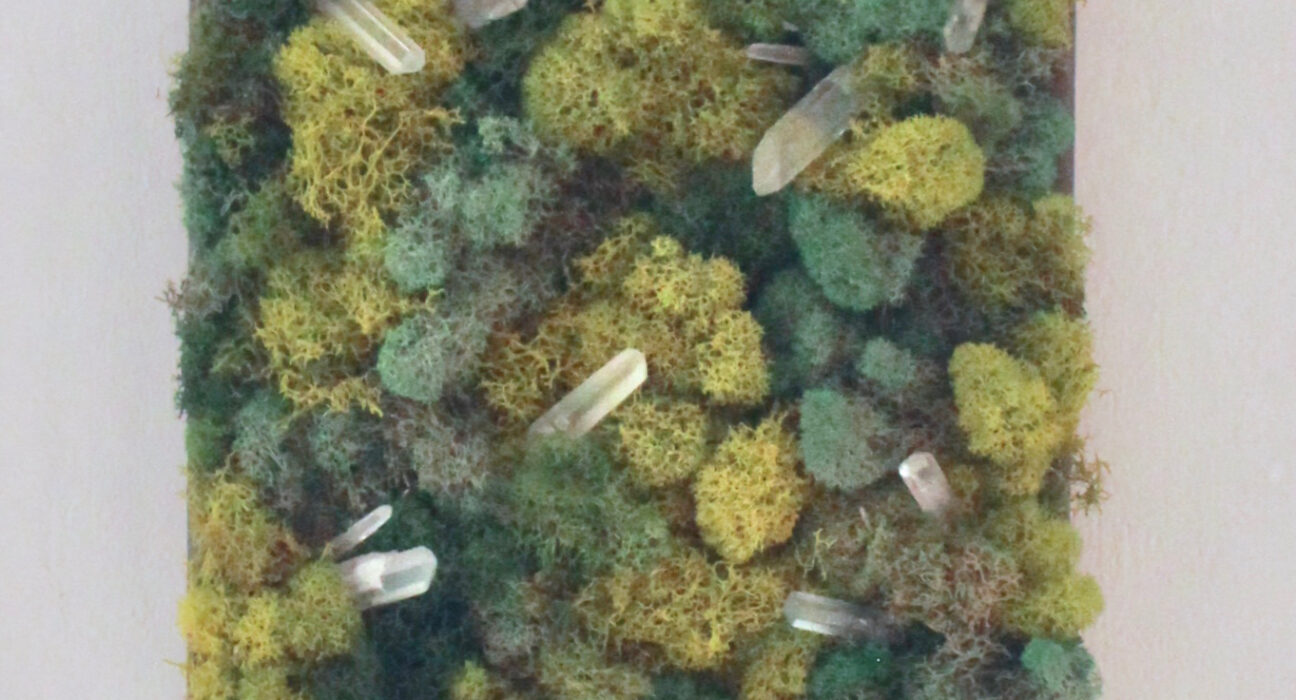
Maria Citarella
Living Magic.
Nosegay
Institute Library
847 Chapel St.
Through June 23
Living Magic, by Maria Citarella, is mounted unobtrusively on the front wall of the gallery, looking — at first glance, from a distance — like an orderly triptych, a study in greens. But as you approach, the lines in the piece grow more complex, and the three panels take on dimension, until you can see that the panels aren’t of paint, but of mosses and lichens. The piece comes to life, nudging over its own borders. It’s easy to imagine that if you came back in a month, the mosses would be bigger still, creeping onto the wall. A year later, maybe they’d take over the wall. In a century, maybe the entire gallery.
The piece is part of “Nosegay,” a “a plant-based exhibition” curated by Maxim Schmidt that explores the “general theme of flora, zeroing in on the magic and beauty of plant life,” as an accompanying statement notes. The 33-artist show, running now at the Institute Library’s upstairs gallery, has drawn so heavily from its inspiration that it feels almost as though a forest has been planted inside, exuding simultaneous feelings of calm and life.
It’s a show with a lot of texture. The Institute Library’s display cases are full of individual pieces, from Bailey Murphy’s whimsical refrigerator collage Puppet Sandwich to Mary Dwyer’s simple and compelling painting I Want This, in which a plantlike being seems to be taking matters into its own green hands. Its display tables likewise mix media, whether it’s Andree Brown’s ceramic pieces that feel like aquatic plantlife or Aly Claire’s Moon Blessings, which drapes an entire piece of furniture in grass and adorns it with cyanotypes of plants, all of which viewers are welcome to touch. A mobile — one of two — hangs suspended from the ceiling, made from a tree branch and a series of photographs. One part of the exhibition even features actual living plants; a large clear jar of water nearby speaks to their need to be watered.
The show’s fecundity is a mark of Schmidt’s playful and exploratory approach to curation. For Schmidt, it was also a chance to put a few ideas he’d had about fostering community into practice. “I’ve collaborated on a lot of projects, but it’s the first time I’ve put something on site that has just my name on it” as a curator, Schmidt said. So the show “speaks to everything I care about in terms of what we’re able to foster in this space.”
Schmidt.
The seed for the show was nurtured in garden collage workshops Schmidt had been hosting at the library. “We’ve been getting 30 or 40 people every session,” he said, a “co-working free-for-all.” The original plan was to put on a show of the collages artists came up with in the workshops and some of the pieces in the show are exactly that. But “a lot of people just fell in love with what they made and brought it home,” Schmidt said.
But a show centered on plants still had plenty of room to grow. “Most people have some sort of perspective on plants, whether it’s that you just like flowers, or you feel strongly about sacred forests, or you’re examining moss and lichen. Everyone has their thing,” Schmidt said. He put out an open call, “free to everyone,” and ended up with 33 artists that ran the gamut from people who had never had work in a show before to artists “who have exhibited many, many a time.” The youngest person is 5 years old and the oldest is in their 80s.
Andres Madariaga
This America.
Some artists headed for explicitly enviromental themes, like Alice Prael, who repurposed plastic garbage to make a mobile. Andres Madariaga painted canvases of migrant agricultural workers. Barbara Hawes made paintings of nosegays. “There are works that are very minimalist and sophisticated,” and “there’s stuff that’s a lot more fun and whimsical.”
But for Schmidt, it all speaks to a general point, of “just being able to appreciate something like a bouquet” and think “not everything in the world is on fire. Flowers are still doing flower things.” Even Madariaga’s paintings are cheerier than most depictions of migrant laborers are. He gives us portraits of people who, among other things, know their work and understand the plants they work with, better than most. As the artist explained to Schmidt, the job may be exploitative, but also, “what if the people see it as a point of pride or a possibility?”
The show in general is “a breath of fresh air” to Schmidt — not only in the common way we use that phrase, but as an examination of a moment in nature that “can be so simple, but so gratifying to be in, to experience.”
“The thing I’m proudest about in terms of this exhibit is that it really feels to me like a testament” to the fact that “there’s enough room at the table for everyone,” Schmidt said. “If you make the space, they will come.”
For Schmidt, a crystallizing moment arrived on the show’s opening night, when the artists gathered together, many of them meeting one another for the first time. “We always throw a good party here,” he said, but in his opening remarks, he found himself speaking to something broader than camaraderie. “Isn’t it so nice that this could be an inclusive space instead of exclusionary? When we’re all hearing ‘no’ and ‘you’re not good enough’ all the time, especially now?”
“I have strange feelings about unity right now because obviously unity is hard,” Schmidt said. But “who doesn’t like to go sit in the grass and just catch a breeze and look at the flowers around them, and think, ‘ah, I’m alive?’… Sometimes that’s enough, you know?”
“Nosegay: A Plant-Based Exhibition” runs at the Institute Library, 847 Chapel St., through June 23. Visit the library’s website for hours and more information.

